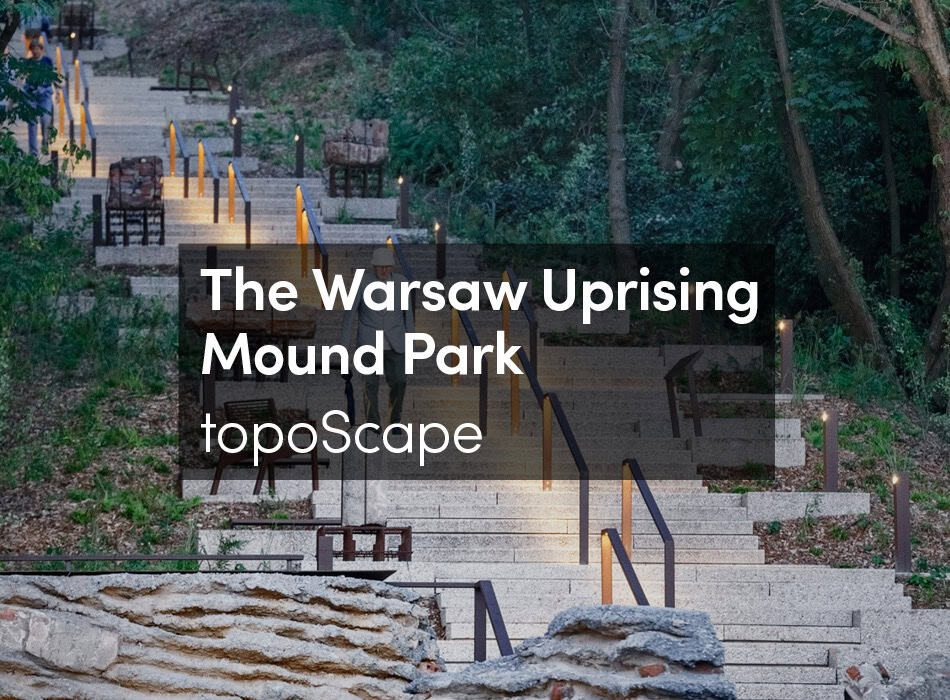urbanNext interviews Urban Nouveau on Lidingö Bridge Village project and their proposal to repair Stockholm’s landmark.
 The Gamla Lidingöbron apartments. 50 apartments fit inside the structure of the bridge.
The Gamla Lidingöbron apartments. 50 apartments fit inside the structure of the bridge.
What made you want to support the repair of the bridge even though the local council didn’t want to invest in it? How will you convince them?
We have a magnetic connection with Gamla Lidingöbron. The bridge is an important landmark for Stockholm: it is unique and has a high cultural historical value. Unfortunately, the local council has ignored these facts and is using mainly two arguments in their decision to demolish this icon: a) that it is cheaper to build a new bridge and demolish the old bridge than to refurbish the old bridge; b) that the structure of the old bridge is in bad shape and therefore needs to be demolished. Both of these arguments are not necessarily correct.
Urban Nouveau’s proposal features 50 apartments inside the structure of the old bridge. This strategy generates a minimum of SEK 850 million, SEK 450 million of which are channeled into the total refurbishment and strengthening of the old bridge, leaving plenty of capital for building the apartments. Our proposal has been fully costed out by one of Sweden’s greatest contractors; it is also cheaper and environmentally safer than demolishing and rebuilding.
We understand that changing a political decision is difficult, and we trust that the municipality will come on board with a better alternative very soon.
Why do you think combining infrastructure and housing is a good idea?
It is the best way forward in this unique situation. Currently, Gamla Lidingöbron is under a lot of pressure since it supports one track for the local island tramway, bicycles lanes and a pedestrian path. It is tight. The local council has decided to have two tracks for the tramway. With our proposal, only pedestrian traffic will remain on the old bridge. The two tramway tracks and the bicycle lanes will be relocated underneath a different bridge (which runs parallel to the Gamla Lidingöbron) on three independent structures. This combo-proposal tells a story about sustainability. It does not make sense to even think of demolishing a bridge that can be refurbished in order to build a new bridge that does not need to be built. We have to improve our capacity to activate the existing context.
 Section: situation today. Gamla Lidingöbron (left) supports the tram traffic, cycle traffic and pedestrian traffic. Cars run on Lidingöbron (right).
Section: situation today. Gamla Lidingöbron (left) supports the tram traffic, cycle traffic and pedestrian traffic. Cars run on Lidingöbron (right).
Section: situation tomorrow. Gamla Lidingöbron (left) supporting a pedestrian park over the new apartments. The foundations of Gamla Lidingöbron are strengthened with new piles and new pile caps. The steel structure is fully renovated and strengthened with new columns and new pre-stressed tension cables. Lidingöbron (right) hosts three new bridges for trams and cycle traffic. The foundations of Lidingöbron are strengthened with new piles and new pile caps. The columns are reinforced.
How does the functionality of a public bridge coexist with the privacy of dwellers in the same structure?
The situation can be compared to row houses with a public park on the roof, but the row houses are located on the water. From the park, the apartments are invisible; they are accessed by individual stairs and elevators from the park. The public park will be owned and maintained by the two municipalities that it connects: Stockholm and Lidingö. The structure below the park will be owned and maintained by the dwellers who will pay a monthly fee to a housing association. The park on the roof and the apartments can coexist in perfect harmony.
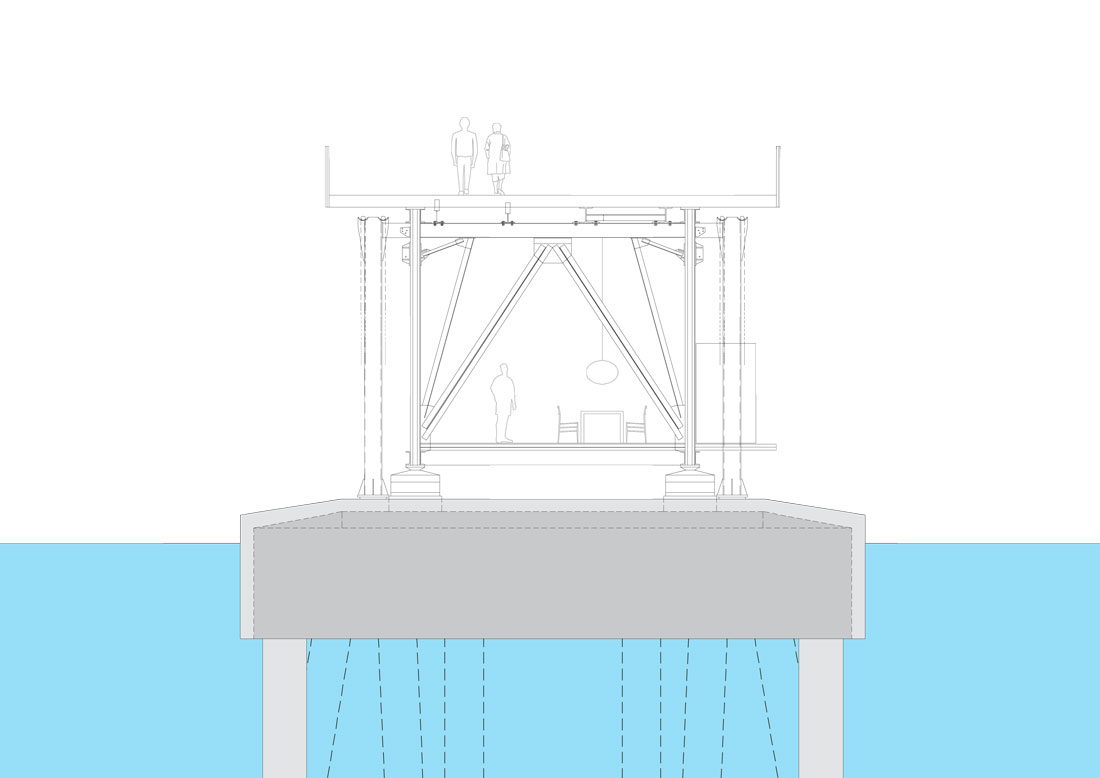 Section through the Gamla Lidingöbron with apartments inside the structure and the pedestrian park on top.
Section through the Gamla Lidingöbron with apartments inside the structure and the pedestrian park on top.
How do you approach the idea of housing in such a unique location?
The idea of inhabiting the bridge was born in 2006 when Filipe Balestra and I lived on the island of Lidingö and crossed the bridge on foot every day on our way to and from Stockholm. In the morning, the sun would rise on the east side of the bridge, marking the beginning of the day with a magical moment, and in the evening, the sunset on the opposite side would color the sky pink and make the water sparkle. Stopping at the center of the bridge became almost a ceremony, and at one point we asked ourselves whether the bridge could be a good place to live. We thought of many programs that could be accommodated by the space inside the bridge. We chose housing because there is a shortage of housing in Stockholm and because of people’s reactions upon seeing the proposal. At the moment, 12 out of a total of 50 apartments have been reserved by potential buyers. And we have not even begun the sales process.
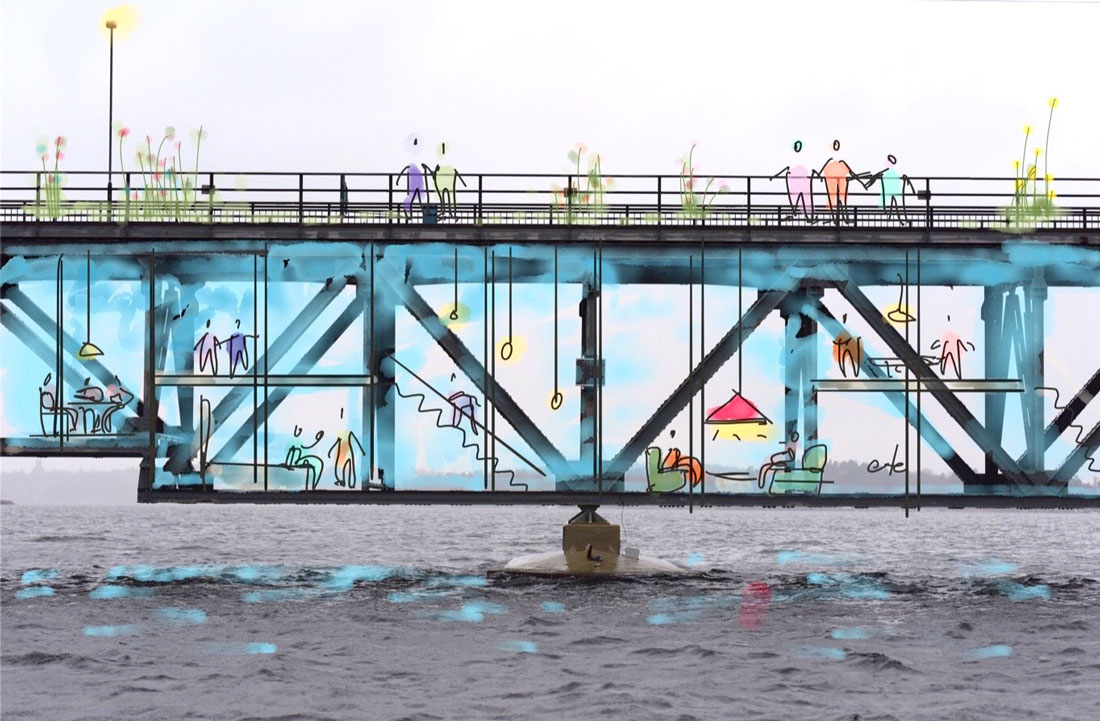 The first sketch of dwellings inside the Gamla Lidingöbron with a green park above.
The first sketch of dwellings inside the Gamla Lidingöbron with a green park above.
What are your priorities in terms of housing design in catering to today’s lifestyles?
Each apartment is meant to be customized. When someone buys an apartment from us, the price includes time with an architect to shape the plan according to the client’s needs and desires. The plans will be a surprise.
What benefits does your proposal bring to the city?
The new landmark and its iconic development will attract global tourism to Stockholm. Our proposal brings a green and active public space to a densifying part of the growing city. We believe that the revitalized bridge will strengthen the relationship between Stockholm and Lidingö, and for the local inhabitants of Lidingö it will be a victory to keep the Gamla Lidingöbron as the symbol of their island.
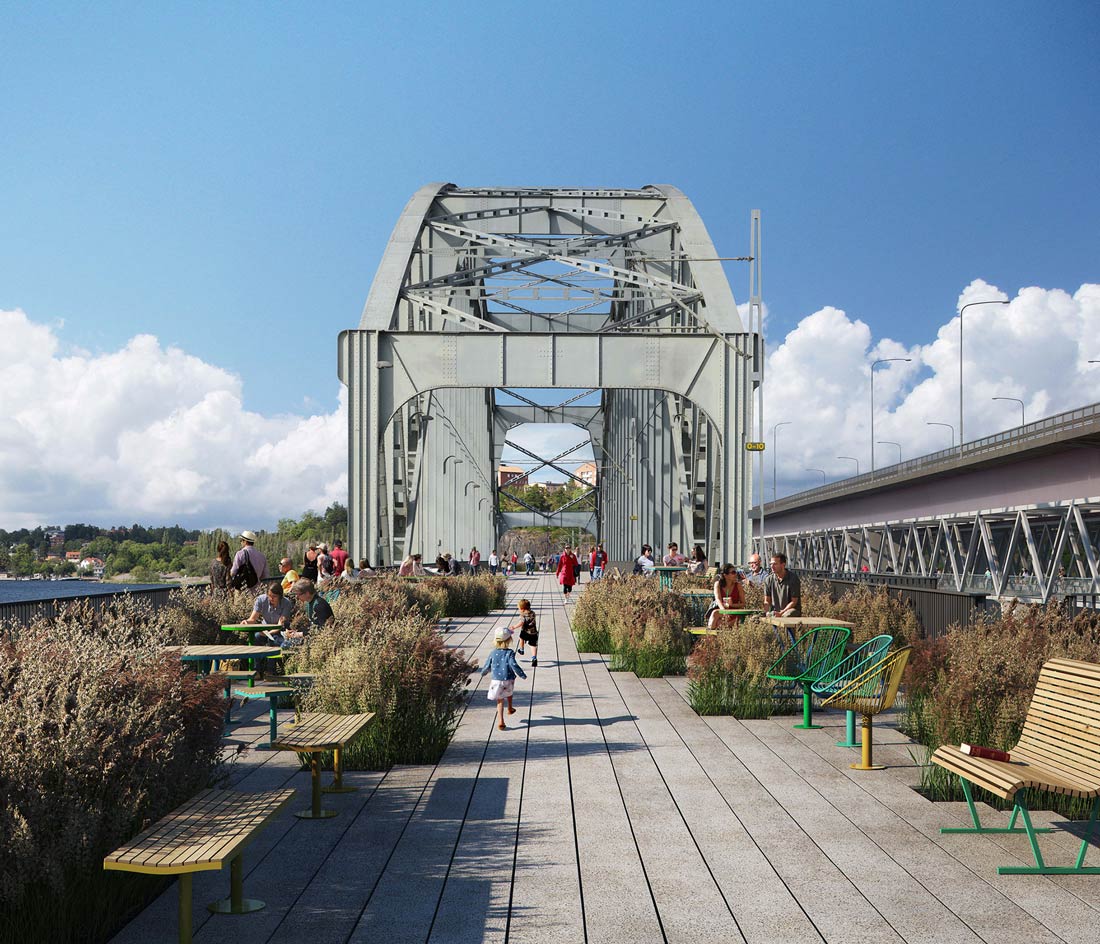 The public park: a social and ecologic viaduct between Stockholm and Lidingö is open for the public 24-7.
The public park: a social and ecologic viaduct between Stockholm and Lidingö is open for the public 24-7.
How are you planning to turn the bridge into an active public space?
The 750-meter-long park will be programmed and divided into zones where different activities can take place. We are designing custom-made furniture and equipment for the public park to facilitate activities such as fishing, exercise, play, picnics, meetings, sunbathing, boat watching, bike fixing, etc. There are two existing buildings located near land at both ends of the bridge that will be transformed into a restaurant and a café.
How did you approach the ecological impact of the project?
Tearing down a bridge results in tonnes of waste. Building a new bridge with new foundations has a negative environmental impact on the water. On the other hand, reusing an existing structure and upgrading it is a resourceful approach to architecture and planning, which we apply in all our projects. Furthermore, with the right vegetation in the park it can become an important green link for certain animals to move between Stockholm and the island.
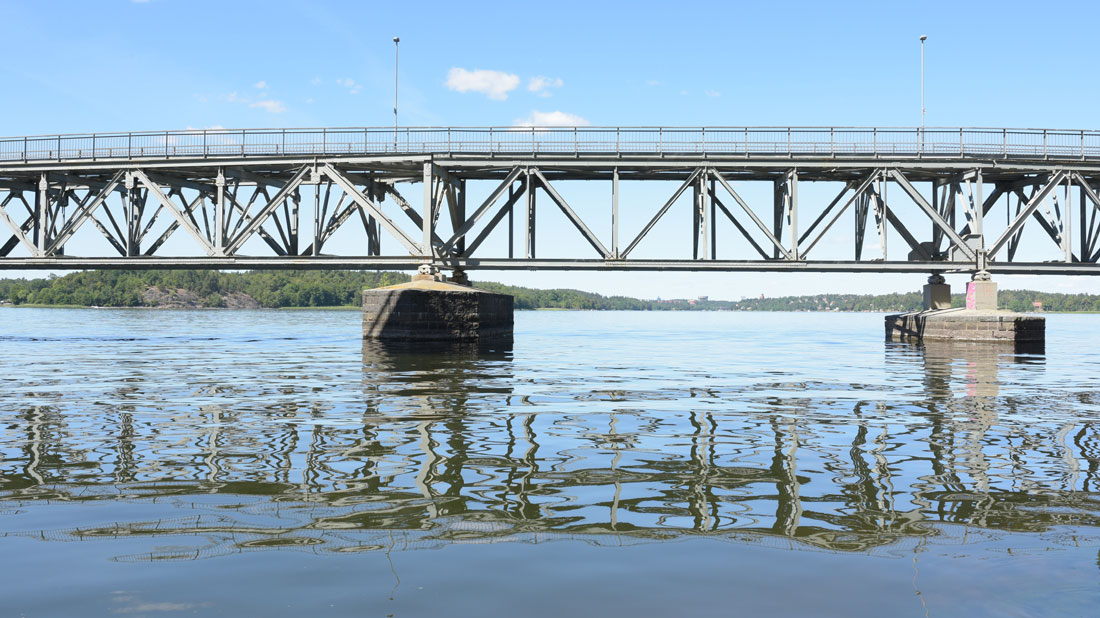 View of the structure of Gamla Lidingöbron (looking West).
View of the structure of Gamla Lidingöbron (looking West).
What particularities are there in the connection between Stockholm and the island of Lidingö? How did you respond to them?
The connection unites two different realities. Stockholm is one of the fastest growing cities in Europe. The growing need for housing is putting pressure on the city to develop new urban areas. In Norra Djurgårdsstaden, on the Stockholm side of the Gamla Lidingöbron, at least 12,000 dwellings and 35,000 work places are being planned and built. At the other end of the bridge, the council of Lidingö is very careful with new development, since their priority is to preserve the island’s green spaces. This translates into small-scale development. Our proposal is an inhabited green connection where both sides can meet.
When describing your project you mention Manhattan’s High Line. What strategies inspired you in this project?
There are several aspect that interest us in terms of the High Line. In 1999, the mayor of New York had decided that the High Line would be demolished to make way for real estate development. Two people got together and were able to change that decision. We believe we can do the same for Gamla Lidingöbron, and we have the perfect team to make it work. The High Line project was not only about preserving an existing structure; it was about creating something extraordinary for the people of New York. The same goes for Gamla Lidingöbron, which will be transformed into a beautiful urban public space and a unique location to live. The concept of a linear park – which can be used simultaneously as a walkway, a place for contemplative strolling, and a place to sit down and meet – was of interest to us in designing the connection between Stockholm and Lidingö.
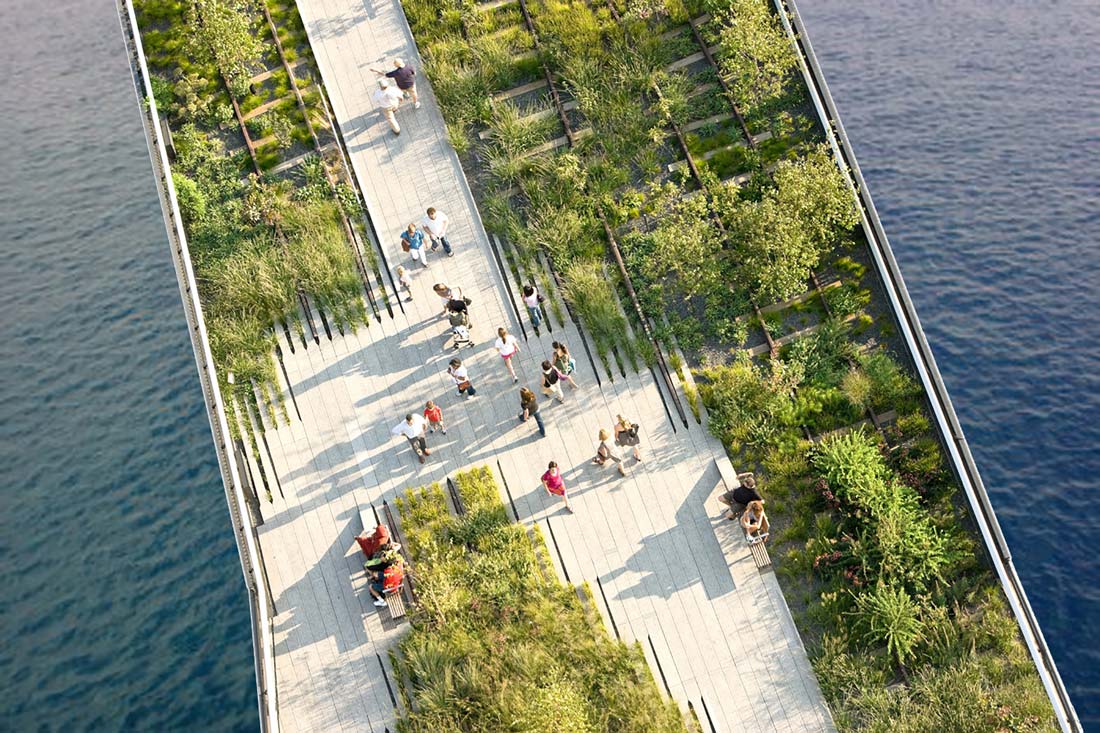 High Line over the water. Collage using a picture from www.thehighline.org
High Line over the water. Collage using a picture from www.thehighline.org
In general, do you think contemporary architecture should focus on reusing instead of building from scratch?
Absolutely. “New” is an old concept. We don’t need to destroy in order to create something new. There is already a soul in a place – story that can be continued. It’s a bit of a Buddhist approach to urban development.
How has this particular project affected your practice in the office?
This project has been with our practice for 12 years. We have invested thousands of hours, and now we are on the verge of making it happen. I believe we have understood that with patience and persistence anything is possible.









